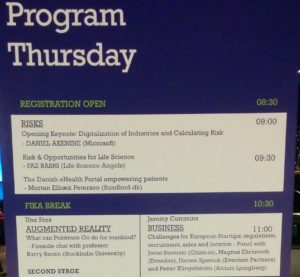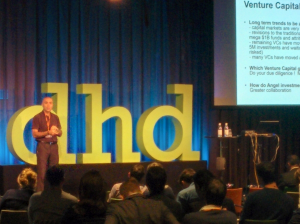„If you throw a stone in Tel Aviv, you will very likely hit an entrepreneur.“
Nowhere in the world can you find more tech startups per capita than in Israel. Like in the famous Silicon Valley entrepreneurship is ubiquitous. It is not without reason that some people speak of Israel as the “Silicon Wadi”. Over the last decades, the unique geographical, political and religious conditions have formed a prospering entrepreneurial ecosystem in what used to be a hostile Middle Eastern desert.
The military plays a crucial role. One of the main factors behind this phenomenon is the Israeli military. Going through a compulsory military training after high school young Israelis receive a thorough education in e.g. Engineering or IT and learn valuable skills like working in teams, coming up with improvised solutions in stressful situations and evaluating risks and opportunities appropriately. At the same time they develop a big network within the army and adapt a hands on mentality. The magazine Business Insider named the military’s notorious elite section 8200 “the best high tech school in the world”.
Ironically, many of the young adults graduate from military questioning authority and striving for independence and self-determination. The result is a crowd of young Battlefield Entrepreneurs ready to start their own companies (cf. “Startup Nation” by Dan Senor und Saul Singer).
Support by various institutions helps startups accelerate and succeed. Those companies have the chance of receiving funding from one of the numerous national and international Venture Capital firms. In 2015 over 1 million USD were invested in Israeli startups. This is ten times the amount, per capita, of investments made in European startups. In addition there are financial support programs offered by the government and over 20 incubators pushing the young entrepreneurs, offering advice, workspace and business connections.
“Founding companies has become Israel’s national sport”
Professor Uzi DeHaan, Technion – Israel Institute of Technology
Geographical factors bring both benefits and disadvantages. Some Israelis argue that the omnipresent danger of military conflicts in their country leads to young people growing up with a feeling of insecurity about the future and makes them more ready to take risks. Obviously the widespread willingness to take risks can foster the development of an entrepreneurial spirit considerably. On the other side of the coin the mentality of looking for fast, innovative, but also short term solutions leads to a vast majority of early exits of successful startups. This means that a lot of entrepreneurs take the first opportunity they get to sell their company to a larger international firm. Thus, Israel misses out on a lot of potential regarding new jobs and tax payments. The Ministry of Economy acknowledges that this poses a problem for the state: „When it comes to creativity Israeli engineers are leading. But the Americans are better in growing a big company.“ To come full circle, due to the lack of bigger developed companies, there is a notable shortage of jobs, which in return increases the likelihood of budding entrepreneurs to start their own business or join an existing startup.
Another influence is the limited domestic market; while startups in larger countries like the US have direct access to an enormous national market potential, Israeli entrepreneurs are forced to apply an international focus right from the beginning. However, this initial disadvantage can turn into a great asset once it comes to scaling up the business activities.
Culture and attitude make Israeli prototype entrepreneurs. Similar to the US, there is no social fear of failing. Thanks to that founders can pursue their ideas without too many second thoughts about their future career and reputation. Besides, the large Jewish network supports entrepreneurs in Israel and globally in a unique way. Success stories spread quickly and encourage other founders. Last, there is Chutzpah. The Yiddish term which describes an inimitable form of audacity, insolence and courage. This distinctive quality of Israelis can be witnessed in the way students talk to their teachers, employees question their supervisors’ decisions and soldiers criticize their generals. One can easily imagine that an environment in which the status quo is deliberately questioned leads to more innovative thinking.
So, if there are three things you, personally, can take away from this exceptional nation it would be:
‘Dare to question what is.’
‘Never mind the conditions, but rather make the best of your potential.’
‘Don’t be afraid to fail – embrace the freedom entrepreneurship can give you.’
–
For a deeper insight into historical and governmental aspects of Israeli startup culture the book Startup Nation by Dan Senor und Saul Singer can be highly recommended.
To learn more about successful startup scenes, check out this blog post about the famous Silicon Valley.
All blog posts in this series are based on years of involvement in the German startup scene, work on several startup projects, travels to various startup hot spots around the world and related discussions with founders, mentors, business angels and investors.



 cles to relax. Electrical stimulation is used to reduce the tension in muscles, as well as spasm. The electrodress is used by people with stroke, brain damage, etc [1]. In the first part of the episode (you can find the link down below) you will see a little girl that, after using the elektrodress, has got the ability of moving her legs and doesn’t need to inject any medication any longer.
cles to relax. Electrical stimulation is used to reduce the tension in muscles, as well as spasm. The electrodress is used by people with stroke, brain damage, etc [1]. In the first part of the episode (you can find the link down below) you will see a little girl that, after using the elektrodress, has got the ability of moving her legs and doesn’t need to inject any medication any longer.
